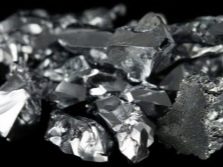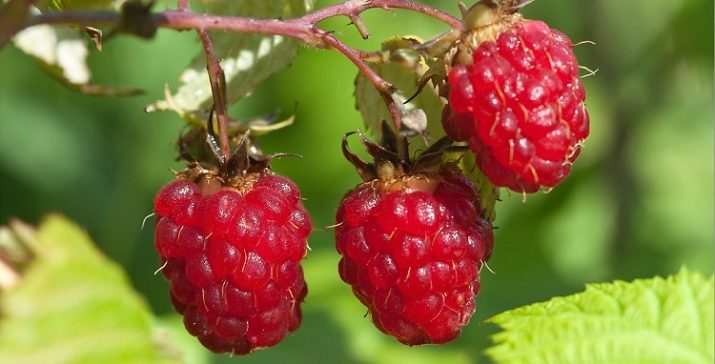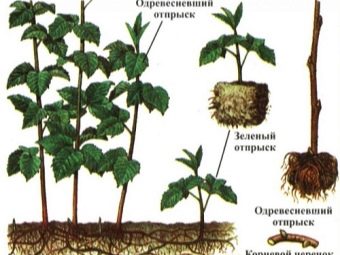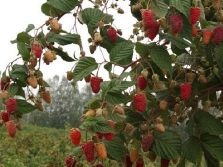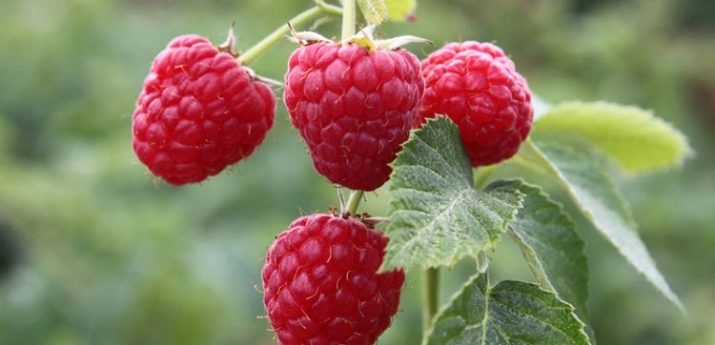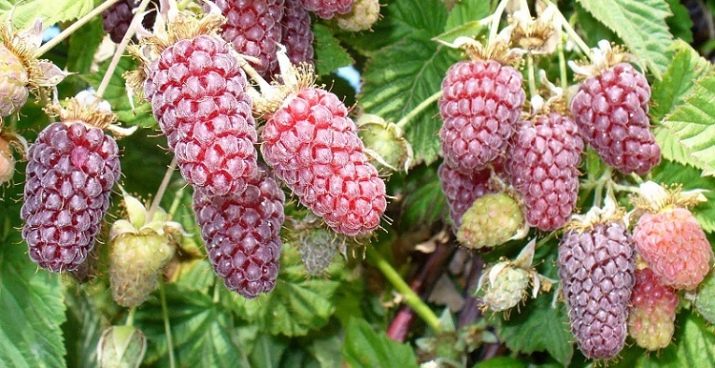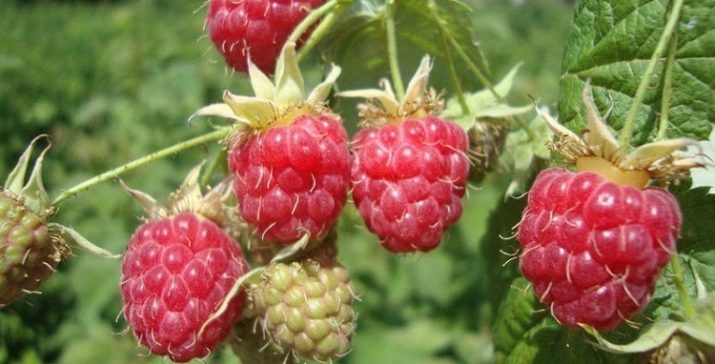The best raspberry varieties: description and features
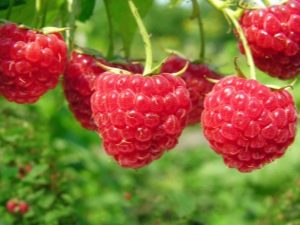
If a sore throat has started, a cough has begun, the temperature has risen, then first of all in such an unpleasant case, many people think about alleviating the symptoms with the help of raspberry tea. And indeed, the sweet berry has wonderful healing properties, the knowledge of which will help to overcome various ailments. But in order to independently grow this curative berry, one should become familiar with the best varieties and their characteristics.
Berry benefits
The fact that raspberry is a medicinal plant, they knew in the III century. Broths and infusions of leaves, berries, and even sliced cuttings have been used for a long time and are now used as an antipyretic, diaphoretic, and light anesthetic. This is because the tissues of this plant contain acetylsalicylic acid and flavonoids - kaempferol, quercetin and their alkaloids. This acid, known as aspirin, is also a preventive agent against the formation of blood clots in blood vessels.
Tannins, saponins, phenol carboxylic acids, coumarins, which are contained in raspberries, slow down the aging of the body, remove radioactive elements, promote good liver function, prevent the development of viral diseases.
The content of trace elements boron and silicon raspberry exceeds other fruits and berries. It also has three times more cobalt than apples and pears, a lot of nickel and copper (1/4 - 1/5 of the daily requirement of 100 g), it surpasses currants and cherries in the amount of manganese. Boron is involved in the exchange of calcium and phosphorus, the formation of bone structure, converts vitamin D. Silicon provides the density and elasticity of fibrous tissues: skin, nails and hair. Cobalt increases iodine absorption, improves protein and carbohydrate metabolism.
Raspberries are superior to black currants and strawberries in carotene, vitamins B2 and C. Berries contain a large amount of fiber (100 g to 33%) and very little easily digestible sucrose (per 100 g not more than 0.2%), which makes them dietary a product that is recommended even for people with diabetes and overweight, as well as with low acidity of the stomach.
Such properties of raspberry cause great interest in its cultivation, despite the fact that it grows on almost the entire territory of Russia (except in the Far North) and is quite unpretentious. English and American gardeners began breeding raspberries on their plots in the 18th century. And in Russia, Prince Yury Dolgoruky - the founder of Moscow - laid the first raspberry garden as early as the XII century.
Growing up
Common raspberry - deciduous shrub Rosaceae family (Rubus idaeus). This is a perennial, ligneous, winding plant with a lot of adventitious roots in the rhizome, from which the above-ground biennial shoots develop, reaching a height of from 1.5 to 2.5 m. literally like a weed. Therefore, raspberries are usually planted on the edge of the plot along the fence.
In addition, it is recommended to dig around the perimeter of the plot to a depth of about 15 cm into the ground pieces of slate or board to limit sprawl.
It is possible to plant raspberries both in spring and autumn, but it is preferable to plant in the fall - in late September or early October, before the onset of frost. It is best to grow a bush from cuttings or saplings purchased from reliable producers or in nurseries. When buying you need to pay attention to the fact that the shoots were strong. Planting material with thin or stained branches is not recommended.
Landing steps:
- Before planting the plant in the soil is recommended to water the root system.
- For each seedling you need to dig a planting hole 40-60 cm deep, depending on the size of the root. It is good to add compost mixed with ashes to the soil.
- It is necessary to install a trellis with a height of about 1.5 m. Between the supports pull three rows of wire at different heights.The bottom should be about 0.5 m from the ground. For some varieties (for example, shtambovy) trellis may not be required.
- Raspberries should be planted at a distance of 40 - 50 cm between plants and 1.5 m between rows. The root neck is sunk no more than 5 cm. After planting, watering should be carried out.
- Shoots need to be shortened to 50 cm.
Care of seedlings
Raspberry is a heat-loving plant, so a bright place should be chosen for planting, but it is better to plant a shrub in the east or west side of the site so that it is protected from midday sunlight. Raspberry prefers slightly acidic moist soil, sandy loam or loam is ideal. Watering should be plentiful, but there should be good drainage so that the water in the soil does not stagnate and the roots do not stop. Mulching will help to maintain optimal humidity, but deep loosening is not recommended.
Feed the raspberries required regularly. It responds well to organic fertilizers, you can add ash. Also suitable for seasonal universal dressing. But since July, it is better not to fertilize the bush any more and not to deposit potash-phosphorus mixtures, so that the shoots of this year are strengthened, and new ones are not formed, which by the winter will not have time to woody and may freeze, which only weakens the plant.
For raspberries is very important timely pruning. Since the plant is sensitive to light, thick plantings should not be allowed to form. In the fall, you need to cut out the seedlings. Usually these are branches of the second year, it is on them that traditional varieties produce fruits.
At the repair raspberry, it is sometimes recommended to cut the entire shrub, because its first-year branches are fruitful, and the plant winters better. You also need to remove weak and damaged shoots, and in the spring - excessive green growth.
As the branches grow, it is recommended to tie them to a trellis, and in June they should be pinned at a height of about 80 cm. Thanks to this technique, the same-age shoots form side branches over the summer, on which berries will be tied next year and the harvest will increase.
The frost resistance of plants is average, they can die at a temperature of -28 - -30 degrees, so they should be covered for the winter. Shoots bend down to the ground and fall asleep with fallen leaves or cover with spruce branches. There are types and varieties of raspberries with hard erect stems. For such varieties, a good option is the construction of a covering material, for example, a spunbond, thrown over a skeleton.
Pests and diseases
Sweet berry relished not only people. She does not mind eating birds and numerous insects. It is possible to protect a shrub from birds by throwing a net on it and securing it to the ground. With the invasion of the raspberry beetle, weevil, stem fly, aphid, spider mite, vegetable infusions with soap can be used. After harvesting, the use of chemicals is possible: Aktillik, Fufanon, Fitoverma.
Shrubs can be affected by fungal diseases: anthracnose, purple spot, powdery mildew, rust. The main reasons: infected planting material, thickened planting, high humidity. It is necessary to carry out weeding in time, after harvesting, all sprouts that have been harvested and damaged should be cut and burned. Also in the fight against disease will help fungicides and 1% solution of Bordeaux mixture. Processing is best done during the period of bud break and after picking berries.
It should be noted that raspberries can grow in one place up to 25 years, but it will actively bear fruit 10-12 years. Therefore, to obtain a good crop, it is recommended to update each decade by adding new varieties.
Breeding
There are three ways to multiply raspberries:
- root suckers;
- layering;
- seeds.
It should be noted that the first method raspberry breeds independently, and very actively.A large number of root offsprings appear every year at about half a meter distance (and in some varieties it reaches 2 meters) from the parent plant. Thus multiply raspberries easiest. In the fall, it is only necessary to cut off “children” ready for independent life from the “parent” with a shovel and transplant to a new place.
In the second method, the shoot bends down to the ground, fits into a hole and is covered with soil. It must be fixed with a pin or just a stone so that it does not straighten. Roots are formed in the deepest possible place. A sufficient number of roots in this case is formed in the spring, at this time it is necessary to separate and transplant a new plant.
With the first two methods, a seedling is obtained that fully preserves the characteristics of the parent plant. But with the third result is not always predictable. If the seeds are purchased, and the manufacturer is conscientious, then you will receive such a plant, which is described in the description on the package. And collecting the seeds yourself, even from a varietal shrub, you risk getting seedlings with the most unpredictable properties.
Therefore, the third method is very suitable for those who like to experiment. And those who do not have a summer cottage, you can try to grow delicious berries from the seeds on the balcony.
Growing from seed
It is better to sow raspberries in autumn, as the seeds require stratification. Therefore, if spring sowing is still planned, then they need to be held for several days in a cool place at a temperature of 0 to +5 degrees, wrapped in a damp cloth.
First, seeds are sown in any suitable container filled with peat-sand mixture, deepening about 1 cm and sprinkling with humus. It is better to cover the container from light, the soil should be kept moist. If the germination is good (which is rare, some seeds may even rise not in the first year), the plants need to pick out.
In a permanent place, seedlings are transplanted with the appearance of several leaves. Capacity for seedlings should be larger (7 - 8 liters), with good drainage or a hole for the outflow of excess water. The soil is made from peat, sand and humus, taken in equal proportions.
In the formed bushes usually leave from 3 to 5 of the strongest shoots, the rest are cut. The care as a whole does not differ from the conditions created on the site, the plant is fed and watered in time.
It is only necessary to closely monitor the temperature and humidity conditions. This is important for all container plants, as the soil and root system can dry out quickly in a limited volume. In addition, the balconies often get direct sunlight, from which seedlings need to be covered.
Trimming is also important. The shoots are left as long as the balcony conditions allow. For container raspberries need to properly organize the winter. Roots should be insulated with the first frost. But do not rush to remove the plants in the heat.
To form a kidney for the next year, you need a temperature below +5 degrees. Therefore, under such conditions, the bushes withstand 35 - 38 days, you can even put them in the refrigerator. Then the plants are transferred to a room with a temperature of about +18 degrees, where they hibernate. Weak shoots cut out, leaving 3 - 5 strong.
Over the centuries of breeding, both foreign and Russian gardeners have developed a huge number of raspberry varieties. In the State Register of the Russian Federation introduced more than 90 varieties, differing in appearance, ripening, taste and even color.
What types are there?
It is accepted to divide the garden raspberry into three types:
- traditional (ordinary);
- large-fruited;
- remontant.
Traditional raspberry varieties are close in properties to the forest "ancestor". They are reliable, can grow in different soil and climatic conditions, bear fruit on the shoots of the second year.Plants form a large number of root shoots, which, depending on the situation, can be considered both a disadvantage and advantage, for example, if you need to quickly multiply plantings, this quality will be very useful. The disadvantages include low, compared with other types, yield.
The variety "News Kuzmina", referring to the traditional form, despite the venerable age (bred more than 130 years ago), is still considered the benchmark of raspberry flavor. It is often found in gardens, although it requires increased attention because of its sensitivity to drying out, diseases and winds.
The name "Large-fruited" speaks for itself. Berries of these varieties can reach a weight of up to 12 grams or more, have a pronounced taste and aroma. Fruitful shoots branch out, which increases productivity. At the same time for large fruits require improved conditions: enhanced fertilizing and watering. Remontny varieties give the crop twice during the year. The berries of the second wave are usually larger. This feature is due to the fact that the fruits are tied on the shoots of the first year, and on the biennial shoots.
Candidate of Agricultural Sciences Evgeny Yaroslavtsev allocates autumn varieties as a subspecies. They are distinguished by the fact that flowers and berries are formed on the whole annual runaway from top to bottom, and not just on the tops, like other remontant varieties. The shoots realize their potential by 80% in the first year, so they can all be cut for the winter, which greatly simplifies maintenance.
A separate species combines relatively new standard varieties similar to the “raspberry tree”. They are distinguished by powerful upright shoots that do not require binding to a trellis. On the other hand, this complicates the maintenance of wintering of plants, since it is impossible to bend the branches to the ground, and it is necessary to construct a shelter. Perhaps the most famous of the standard varieties - "Tarusa".
Multicolored berries
In nature, raspberry has a dull scarlet color. Yellow berries are less common. As for the cultivars, the palette is much more diverse. In addition to all kinds of shades of red, yellow, orange, apricot colors are presented. Many yellow-fruited varieties have evolved from the red “Kuzmin’s News”.
There are even plants with purple-black berries. Often found variety of such coloring - "Cumberland".
When ripen?
The ripening period is a very important varietal characteristic. But such a classification is sometimes very conditional. For example, plants of remontant varieties are capable of producing two waves of the crop, that is, the berries ripen early on stored biennial stems, and at a later date on annuals. In this case, the assignment to one group or another is due to the time of the main, more abundant collection.
There is another important point: raspberries, even on an industrial scale, can be grown indoors. This, of course, will also contribute to the earlier ripening of the fruit than indicated in the varietal characteristics.
The growing region also matters. In the same variety in the southern region of the berries ripen earlier than in the more northern.
Since early raspberries begin to fructify at the end of June, and the latest varieties can produce fruits up to frost, in order to extend the period of harvest, you need to have several varieties of plants on the site that ripen at different times.
Characteristic varieties
Early
The most popular early varieties are as follows.
"Balm"
The grade is known for a long time, well grows both in an average strip of Russia, and in other regions of the country. The bush is upright, forms 15–20 shoots reaching a height of 1.8 m per 1 m2. Annual branches are bright green, biennial have a light brown color. Dark purple berries of medium size (up to 2.7 g) have the shape of a wide cone, the taste is sweet-sour.
The yield level is considered above average, the berries ripen at the same time, up to 2.8 kg can be collected from one bush.
The variety is not very common, as many are not satisfied with its taste. But I must say that the fruits of this raspberry are dense, transportable, can be stored for a long time, suitable for processing. It is important that the variety is frost-resistant, reliable, does not vyvrevaet in winter, resistant to diseases.
"Brusvian"
Remontant, large-fruited variety of domestic breeding. A very tall bush reaches a height of 2, and sometimes even 2.5-3 meters. The shoots are thick, arborescent, but still worth binding them. The berries are bright red, large, but 15 grams indicated in some sources, according to reviews of gardeners, do not reach, the average value is 9 g. The yield is 4-5 kg from a bush.
The variety is valued for its pleasant sweet-sour taste and the density of berries, of which many people like to make jam. Harvest can be collected in mid-June. And the second wave falls in August - September, which is why “Brusvian” is sometimes referred to varieties with an average ripening period. Another nice feature - a small number of thorns on the stems, which facilitates the collection of berries.
For the winter requires shelter, but can withstand temperatures up to -22 degrees. The variety is sufficiently resistant to diseases and pests.
"Sun"
Fast growing tall variety. In the bush can give up to 20 powerful replacement shoots. Stems with small thorns reach 2 meters in height. Purple berries of round shape, reaching 5 grams in weight, have a pleasant sweet taste, have a pronounced aroma. In winter, the variety does not freeze, it is also resistant to fungal diseases.
"Pshehiba"
Polish novelty, non-repair, tall. Occurs from the famous variety "Lyashka". At about the same early dates (end of June), it ripens.
Brilliant berries of light red color have a sweet dessert taste, elongated conical shape. They are very large, reach a diameter of 5 cm. The variety is still only being developed by Russian gardeners.
Average
Cascade Delight
Famous American variety that has been cultivated for over 20 years. The bush is very tall, shoots can grow up to 3 meters. Stems covered with spikes in the middle. Variety is valued for large (6 - 7 g) beautiful dark red berries, very fragrant and sweet in taste.
Fully ripened fruits are easily removed from the receptacle, not showered. They can be stored for a long time without losing their form and taste, and are quite transportable. Also let's say mechanized collection.
Fruiting simultaneously, in a short period, you can collect all the berries. At the same time, the yield is excellent, one bush can produce up to 8.5 kg of fruits, this depends to a small extent on weather conditions. The variety can be assessed as unpretentious and winter-hardy, it is not susceptible to soak and rot.
There is a small drawback - the plant develops slowly in the first year. You need patience, then this raspberry will compensate for such a long process in the future.
"Freemen"
Large-fruited variety recommended for the North-West region, non-repairable. It was bred by Russian breeders when they crossed popular and proven Brigantine and Bryansk varieties and combines the best qualities of "parents".
The variety grows moderately, it is characterized by shoots of medium height with a small number of purple thorns, thick enough to not need support. At the end of July, they begin to ripen soft but rather dense bright red berries, reaching 4 grams, containing sugar and acids in equal proportions. Productivity can be up to 4 kg from each bush.
Glen Ampl
Varieties whose names begin with the word Glen are the works of the Scottish breeder Nikki Jennings. They are distinguished by powerful stem shoots and large berries, they can be grown both in open ground and in greenhouse conditions.
The trunks of the massive Glen Ampl variety can grow to a record 4.5 meters. Strong shoots really resemble trees.Up to 1.5 kg of fruits can be obtained from only one such stem, while on average from the whole bush 4.5 kg. And a very convenient property for harvesting - the complete absence of thorns. Dense berries have a rounded, slightly elongated shape and a sweet and sour taste characteristic of raspberries, as well as a pleasant aroma.
Under favorable conditions, the weight of the berries can reach 10 grams. They do not fall out of the bush for a long time after ripening. Fruiting lasts about a month, starts closer to the end of July. The berries are well preserved, transportable.
The variety is resistant to all diseases except root rot, so it is important to avoid over-wetting the soil during care. It forms shoots sufficient for rapid reproduction. And one more small drawback - the bush reaches maximum fructification only in the second, and even in the third year after planting.
"Glen Fine"
Tall variety (up to 2.5 m), although it is lower than the Glen Ampl. The shoots are strong, without thorns, so do not need support. Bushes are compact and high-yielding.
Fruiting starts from mid-July and lasts for quite a long time, so you can not particularly rush with the harvest, because the berries are not showered. They can stay on a bush for up to five days without losing their qualities.
And the berries are very sweet, and in 2009 they were recognized as the most delicious. Yield variety was the winner in 2010. And this is not surprising, because with one square meter you can get up to 30 kg of juicy fruits.
Glen Fine is a winter-hardy variety that tolerates drought well, but an excess of moisture can be disastrous for it. It is also sensitive to powdery mildew and phytophthora.
Glen Coe
Tall variety. The shoots form long and thin, so the plant requires support. It has stems without thorns. There are practically no root shoots.
Pinkish-purple berries have a sweet taste and a pleasant aroma, begin to ripen in the second half of July, fruiting continues until mid-September. The variety is hardy, reliable and productive (3-4 kg from a bush).
"Bell"
Variety "Bell" bred in Siberia. He is known since 1991. Gained popularity due to the wonderful honey taste reminiscent of red bell berries (3.5 g in weight) and good yield. It is believed that from one adult plant you can get 6 - 7 kg of fruit. And according to reviews of gardeners, with proper care, "Bell" is able to bring even greater yield.
The berries begin to ripen in mid-July, and this happens in a very short period of time. With the collection it is recommended to hurry so that healthy and tasty fruits do not crumble. The shoots of this variety are erect, covered with small spikes, grow to an average of 1.5 meters. So that they do not bend under the weight of the berries, you should fix them on the trellis. After fruiting, they dry out and break out easily.
The Siberian variety is resistant to frost (up to -20 degrees), drought, fungal diseases and spider mites. But the stagnation of moisture for him is very dangerous, like drafts. It should also be noted that the quality of berries strongly depends on weather conditions and the sun. Often, the leaves are strongly enlarged by strongly expanding leaves, so they must be periodically thinned.
"Mirage"
When the bushes of this variety from top to bottom are covered with bright red berries, which emanate a thick smell of forest raspberries, it is very impressive. The variety deserves special attention because of the taste of the fruit and abundant yield. Back in the 90s, due to the lack of newer products superior in sustainability, the variety was grown in the southern regions on an industrial scale. Now, due to the tendency to freeze, such plants are found only in summer cottages.
Srednerosly shoots (up to 1.8 m) are covered with soft spikes. The ability to form overgrown medium, sufficient for reproduction.
Berries ripen from mid-July to mid-August, with good care can reach 10 - 12 grams. Productivity is high, from a bush it is possible to receive up to 6 kg of fruits.The berry is dense, does not bake the sun and does not become watery in rainy years. In the middle latitudes of Russia in the winter needs shelter, the bush is prone to sprouting. The plant has no other obvious disadvantages.
"Eurasia"
Remontny productive variety. Fruiting is stretched, it has time to give all the berries to frost. Tree straight shoots grow to 1.5 m, so do not need support. Dark crimson frosted berries have a large size (4-6 g) and a typical sour-sweet taste. Important benefits are soil resistance and drought tolerance.
"Black Jewel"
American black variety, which is self-pollinating. If there is a desire to preserve this color feature, then it is better to grow plants away from the plots with red and yellow raspberries so that they do not overflow.
Shoots tall, straight, reach 2.5 meters in height, densely studded. Radical shoots variety does not form. It is better to grow the plant on the trellis, since for such growth the branches are not rigid enough.
Berries have a peculiar taste without sour taste. The first ripe fruits appear in early July, the harvest lasts until early September. Berries have an average weight of about 2.5 g.
It is noted that varieties with black berries are richer in vitamins and nutrients than ordinary types of raspberries. "Black Jewel" is resistant to drought and frost, pest damage, has a decorative appearance. The disadvantage is powdery mildew sensitivity.
"Parple Jewel"
The fragrant dark crimson berries of this variety are poured from the second half of July to mid-September and have an average taste between raspberries and blackberries. Shoots bend down easily, so they hibernate well on the ground, but support is required for growing. There are very few thorns on the stems, no root growth is formed. Cultivar, resistant to diseases.
"Tulamin"
Medium late summer variety of Canadian breeding. Some consider it the benchmark of real raspberry flavor. In Russian conditions, it is preferable to grow in a closed ground, and in the southern regions it is possible to achieve good results even without a winter shelter.
Tulamin is a tall variety that has strong, less-studded shoots. Root seedlings are enough for breeding, but you don’t have to worry about strong growth.
On the taste and flavor of berries reviews only the best. Fruits are large, weighing up to 6 grams. They are suitable for transportation and long-term storage. Productivity with the observance of agrotechnics - up to 3 - 4 kg from a bush. There is resistance to infections.
"Ruby"
Medium late Bulgarian grade. It is zoned for cultivation in the North Caucasus and North-West regions of Russia and has been known since the 70s. It is appreciated for a stable, fairly high yield (up to 120 kg / ha) and large (up to 3.6 g) tasty bright red berries with good product characteristics.
The shrub is formed srednerosly with weak studding, does not grow much. The variety is quite winter hardy and drought resistant. But it is often affected by pests and diseases, resistance to anthracnose is noted only.
"Terenty"
Standard large-fruited variety of domestic breeding. Forms durable low shoots not reaching 1.5 m in height, devoid of thorns. In the first years it grows weakly, in the future the number of shoots increases (about 5 shoots in the bush).
Large berries have a sweet, even slightly cloying taste. Their weight can range from 4 to 10 grams, very dependent on the care and composition of the soil. Productivity also with an average value of 5 kg per bush can be doubled under comfortable conditions. But it should be noted that the pulp of the fruit is delicate, they are not suitable for transportation and storage.
If the air humidity is high, it is not recommended to leave them on the branches for a long time, the berries may sour or moldy, protection against frost, diseases and pests is also required.
Cleopatra
Medium early variety of domestic breeding, which is recommended for the Central Chernozem area. Bush srednerosly with straight shoots. Sweet and sour berries weighing about 3.6 grams have delicate pulp. The average yield is 55.6 c / ha. Diseases and pests damage the plant a little, winter hardiness and heat tolerance are on average.
Late
"Polka"
By name, you can guess that this is a variety of Polish breeding. It was bred in 1993 and is considered one of the best dessert raspberries in Europe. Bush srednerosly, stem height - up to 1.5 m. It happens that the plant can not withstand the severity of the fruit, so it is better to tie it to the trellis.
The yield is high - an average of 4 kg per bush. The shape of bright red berries resembles a thimble, they are neat with a shallow drupe, juicy, but not watery. Fruiting lasts from late July - early August to late September.
If you leave a few shoots for the winter, you can get two harvests, however, with reinforced dressing and watering. The variety is non-frost-resistant, although it has an interesting feature - it can form fruits at a temperature of -2 - 0 degrees, and they ripen.
"Indian summer"
One of the first remontant varieties of domestic breeding (by I. V. Kazakov). Zoned for the central and northern regions of Russia. In the southern regions will not be able to show their best qualities due to sensitivity to drying out of the soil and heat.
It is considered to be middle-late in relation to annual shoots, which are the main wave of the crop - from August to October. If you keep the biennial stems, then the fruiting will be even more stretched - from the last days of June and until frost. With the observance of agricultural technology it is possible to receive up to 3 kg of tasty fruits from an adult plant
Raspberry berries of medium size and oval shape have a weight of up to 3.5 g, a pleasant taste and a very rich aroma. Most of them are usually concentrated in the upper part of high (up to 2 m) shoots. The fruits have a rather dense texture, but are considered not very transportable. Gardeners "Indian Summer" is characterized as a productive, frost-resistant, reliable variety.
"Stolichnaya"
Speaking of this mid-late domestic variety, we should immediately note its main feature that attracts gardeners - very sweet, almost sour, and large (up to 8 g) juicy berries. The Stolichnaya cultivar has been cultivated for over 30 years, but interest in it has not waned.
At high yields (4 - 5 kg from a bush), fruits are easy to collect due to their elongated shape and the absence of thorns on long, hard shoots (up to 2 meters in height). It should be noted that berries can hang on the branches for several days, without overripe and without losing their qualities. The variety is also appreciated for its reliability, unpretentiousness, winter hardiness.
As a disadvantage, a small number of shoots for replacement is noted, which makes reproduction difficult, and the variety is often affected by purple spot. When growing need to pay special attention to this.
"Inaccessible"
Another well-known domestic large-fruited remontant variety. Harvesting can continue until mid-fall.
The bush is medium sized, compact, consisting of about 6 - 7 powerful shoots with an average studiness. Large and sweet berries have excellent commercial qualities. Productivity can be high, but only with proper care.
Reviews of this variety are the most controversial. They praise the variety of those who managed to create appropriate growing conditions for plants. The conclusion can be made as follows: “Inaccessible” is very sensitive to weather conditions and agricultural technology, but will respond to care with a bountiful harvest of ripe tasty berries.
"Red Guard"
Remarkable remontant variety bred by Russian academician I. A. Kazakov. It has a lot of advantages, the main of which is very large sweet dessert berries weighing 12-18 grams. An interesting feature of the variety is accrete fruits.With good care, the yield is very high - 9 kg from each bush and even more.
It is convenient to care for this raspberry, as the shoots are compact and grow low - up to 1.6 m. High resistance to diseases and frost is noted.
"Octavia"
Variety bred in the UK. It can be recommended for southern gardens, as it is not winter-hardy. A tall plant is best grown with support. Large berries with a pronounced taste. "Octavia" is drought-resistant, but with a lack of moisture the quality of the fruits suffers, they become acidic and small.
How to choose for the region?
Choosing the right variety with such diversity can be a dead end for an inexperienced gardener. Of course, everyone wants the berries to be large, the harvest is plentiful, and the care is light. To achieve the desired, it is necessary to take into account the climatic conditions of the region and choose varieties that here will be able to show all their best properties.
So, varieties unstable to frost and wind are not very suitable for North-West Russia (latitude of the Leningrad region), especially for Siberia. For these regions, we can recommend reliable varieties with a medium early ripening period, which before the frost have time to give the entire crop. These include: "Balsam", "Sun", "Glen Coe", "Bryansk miracle", "Rubin". For the South of Russia fit: "Polka", "Heracles", "Mirage".
In the middle lane you can grow almost any variety, adjusting the feeding and watering depending on the conditions of the year. Even not very cold-resistant species can spend a winter in such a climate with shelter. Therefore, preferences will depend only on the gardener's taste, and descriptions of varieties will help to make a choice.
Experienced Gardeners Tips
Raspberries are often underestimated as a cultivated plant. Because of its ability to creep away, it is sometimes treated in much the same way as a weed. Such an attitude leads to the fact that the plant degenerates, yields fall, and the result disappoints the gardener.
If the rhizomes grow old, pests and diseases penetrate the plants, overgrown bushes must be uprooted, plantings should be updated. It is necessary to periodically add and change varieties.
It does not always make sense to buy only recently appeared species. It is better, using the reviews of gardeners or contacting the nursery, to find reliable and unpretentious varieties with delicious berries.
In the next video, see the review of the best raspberry varieties.





